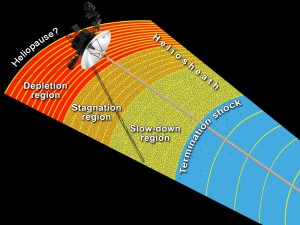MONDAY, 29 JULY 2013
The Voyager probes were launched in 1977 to take advantage of a rare positioning of the outer planets on one side of the solar system; a scenario which would not be repeated for another 175 years. Voyager 1has since travelled towards the farthest reaches of the heliosphere, the cloud of charged particles thrown out by the Sun, and in 2004 reached the shockwave known as the termination shock where the solar wind is slowed to a subsonic speed and becomes turbulent.During July and August of last year Voyager 1 made a transition into an unexpected region at the edge of the heliosphere which has been described in three papers published in the journal Science. In this region the Sun’s magnetic field lines are connected to those of the interstellar magnetic field allowing charged particles from the solar wind to escape and those from interstellar space to stream in.
On 25th August 2012 Voyager 1 detected a 1,000-fold decrease in charged particles originating from the Sun. The removal of these particles has allowed the Voyager team to observe low-energy particles from the interstellar medium that are entering the heliosphere. It is expected that the probe will soon detect a change in direction of the magnetic field as a final indicator that it has passed out of the region and into the galaxy beyond.
DOI: 10.1126/science.1235721
Written by Oliver Pambos.

